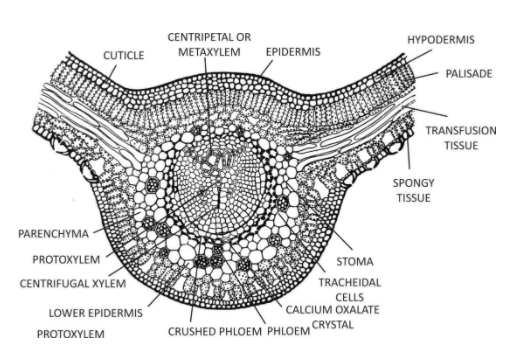
Describe the internal structure of the leaflet of cycas and list out the xerophytic adaptations seen in it.
Answer
558.9k+ views
Hint:Cycas plant attains height of 8-15 feet and appears like a small palm Cycas root are of two types-normal roots and coralloid roots. Leafs of cycas are of two types –foliage leaves and scaly leaves. Each leaf is composed of a petiole, rachis and lateral pinnae. The young leaves show circinate vernation.
Complete answer:
Internal structure of a cycas leaf can be differentiated into a swollen midrib portion and two lateral wings. The wings are curved downwards. The outermost layer of leaf consists of thick-walled epidermis surrounded by layers of cuticle. Upper epidermis is a continuous layer while the lower epidermis is broken by many sunken stomata.

Below the upper epidermis is the sclerenchymatous hypodermis which is more cells thick in the midrib. Hypodermis is absent below the lower epidermis, except in the midrib.
Mesophyll is differentiated into palisade and spongy parenchyma is present only in wings directly above the lower epidermis. Its cells are filled with chloroplasts and are loosely arranged with intercellular spaces, filled with air.
Secondary transfusion tissues are present in mesophyll cells.
Single vascular bundle is present in the midrib portion of the leaflet. Vascular bundles are conjoint, collateral and open. It is diploxylic. Triangular centrifugal xylem is well developed with endarch protoxylem. Phloem is arc-shaded and remains separated by cambium. Phloem consist of sieve tubes and phloem parenchyma. Companion cells are absent.
Parenchymatous cells in mid-rib contain calcium oxalate crystals.
Xerophytic adaptations of cycas leaf:
>Thick cuticle prevents excess transpiration.
>Sunken stomata are present in leaves which prevents loss of water.
>Hypodermis is 1-2 layered and contains lignified cells. It also has mucilage canals which store water and check transpiration which is a xerophytic character.
Note:There are about 200 species of cycas. They are endemic to tropical and subtropical regions and are found in Central America, South America, Africa, Asia and Australia. They are also grown as ornamental plants.
Complete answer:
Internal structure of a cycas leaf can be differentiated into a swollen midrib portion and two lateral wings. The wings are curved downwards. The outermost layer of leaf consists of thick-walled epidermis surrounded by layers of cuticle. Upper epidermis is a continuous layer while the lower epidermis is broken by many sunken stomata.

Below the upper epidermis is the sclerenchymatous hypodermis which is more cells thick in the midrib. Hypodermis is absent below the lower epidermis, except in the midrib.
Mesophyll is differentiated into palisade and spongy parenchyma is present only in wings directly above the lower epidermis. Its cells are filled with chloroplasts and are loosely arranged with intercellular spaces, filled with air.
Secondary transfusion tissues are present in mesophyll cells.
Single vascular bundle is present in the midrib portion of the leaflet. Vascular bundles are conjoint, collateral and open. It is diploxylic. Triangular centrifugal xylem is well developed with endarch protoxylem. Phloem is arc-shaded and remains separated by cambium. Phloem consist of sieve tubes and phloem parenchyma. Companion cells are absent.
Parenchymatous cells in mid-rib contain calcium oxalate crystals.
Xerophytic adaptations of cycas leaf:
>Thick cuticle prevents excess transpiration.
>Sunken stomata are present in leaves which prevents loss of water.
>Hypodermis is 1-2 layered and contains lignified cells. It also has mucilage canals which store water and check transpiration which is a xerophytic character.
Note:There are about 200 species of cycas. They are endemic to tropical and subtropical regions and are found in Central America, South America, Africa, Asia and Australia. They are also grown as ornamental plants.
Recently Updated Pages
Master Class 12 Business Studies: Engaging Questions & Answers for Success

Master Class 12 Economics: Engaging Questions & Answers for Success

Master Class 12 English: Engaging Questions & Answers for Success

Master Class 12 Maths: Engaging Questions & Answers for Success

Master Class 12 Social Science: Engaging Questions & Answers for Success

Master Class 12 Chemistry: Engaging Questions & Answers for Success

Trending doubts
What are the major means of transport Explain each class 12 social science CBSE

Which are the Top 10 Largest Countries of the World?

Draw a labelled sketch of the human eye class 12 physics CBSE

How much time does it take to bleed after eating p class 12 biology CBSE

Explain sex determination in humans with line diag class 12 biology CBSE

Differentiate between homogeneous and heterogeneous class 12 chemistry CBSE




